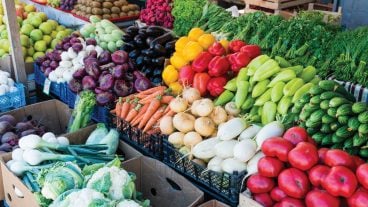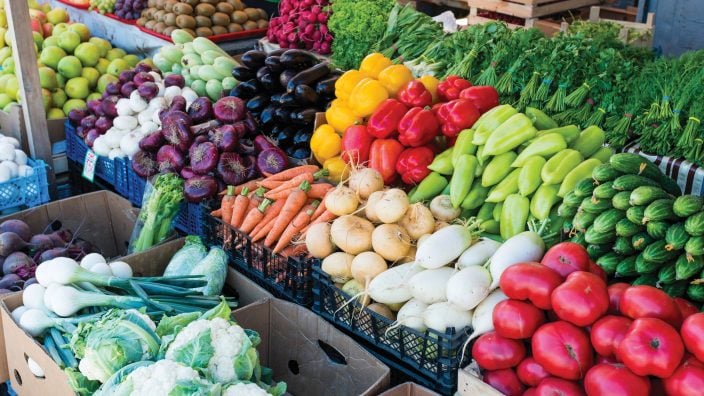Farmer’s Guide to Trucking Regulations available to Ohio Farm Bureau members
The guide includes a farm driver checklist, overview of state and federal regulations and exemptions, CDL qualifications and more.
Read More
If you’ve been trying to make hay this year, you may be a little frustrated with our recent weather. When it comes to making quality hay, the weather will be the deciding factor between mulch (bad) hay and premium dairy hay.
Once mowed, a little bit of rain (less than 0.1″) shouldn’t cause too much damage to the hay, depending on how dry the hay is, but more rain will quickly drop the quality as it will leach the nutrients back into the soil and cause mold issues.
We had two fantastic weather windows for making hay earlier this year with no rain for at least 10 days, one stretch in April and another in May. So why didn’t everyone make hay during these times? It’s complicated and simple at the same time — it wasn’t ready. Hay reaches maximum quality just as it starts to “head out,” or starts to flower. Different grass species mature at different times throughout the year, and you want to plan your harvest to meet that maturity of your preferred species.
For example, most grass hay stands in our area likely have some mixture of timothy, orchard grass and fescue. If your preferred species is orchard grass, you could have baled during the May weather window and harvested a high-quality crop. This is because orchard grass will regrow very well, and you can typically get a second and third cutting of hay without sacrificing much tonnage over the growing season. Several fescue varieties are also similar to orchard grass in maturity and harvest schedules. Timothy, on the other hand, typically does not mature until the second or third week of June, and it is just starting to head out now. If you mow timothy too early, you will sacrifice tonnage, and it does not provide much of a second cutting. Timothy also does not like to be mowed early, and repeated early mowing will reduce the stand over time.
Deciding on when to cut hay is a balancing act between quality, tonnage and weather. Orchard grass can be a challenging species to grow in our area if you are looking to make only dry hay. Most varieties will mature in mid- to late-May, and although this year there was a window to harvest, most years there is not.
If you have the option to wrap hay for baleage, it still can be a good option. For this reason, many people prefer to have timothy as their predominant species in grass hay mixtures. It can provide higher quality at later cuttings, which can add flexibility to your harvest schedule.
When I say quality hay, this means hay harvested at the optimum time will have the maximum feed value. Early-cut hay will still maintain high feed value, but you will sacrifice yield. Generally speaking, once grass hay heads out, it will start to lose feed value. I say generally because some species lose feed value faster than others. Timothy is one of those species that doesn’t lose it as quickly. First-cutting hay that is cut and baled in July typically will be lower quality than June-cut hay. If we are thinking about “horse hay,” June-cut hay is going to fit the bill.
Quality hay also depends on weeds, moisture at baling and many other factors. Hay baled at higher moisture (20% moisture) has the potential to mold in the bale. It may have been premium quality when it was mowed, but when it comes out of the baler it will be mulch hay in a few days. High-moisture hay also has the potential to cause a hay fire. With a short window to make hay last weekend, there may be a few damp bales floating around the county, so monitor your recently baled hay for spikes in temperature. A hay moisture / temperature probe is a valuable tool to have for any hay operation, and checking internal temperatures for six weeks after baling will help identify any hot spots before they become an issue. Once hay is over 150 degrees, you should take action immediately to spread out the hay to reduce the heat. If you measure above 150 degrees, call your local fire department before you start to move hay, as an influx of oxygen may start a fire as you start to move the bales.
If you have any questions about hay or need to borrow a moisture / temperature hay probe, give us a call at 330-638-6783 or email.
Submitted by Lee Beers, an Agriculture & Natural Resources Educator for OSU Extension – Trumbull County.
OFBF Mission: Working together for Ohio farmers to advance agriculture and strengthen our communities.


The guide includes a farm driver checklist, overview of state and federal regulations and exemptions, CDL qualifications and more.
Read More


The Small-Scale Food Business Guide covers federal and state regulations for selling food products such as raw meat, dairy, eggs, baked goods, cottage foods, fruits and vegetables, honey and more.
Read More

ODA will enroll 500,000 acres into the program for a two-week sign-up period, beginning April 22, 2024, through May 6, 2024. Contact local SWCD offices to apply.
Read More

Katie Share of Columbus has been named ExploreAg and Youth Development Specialist for Ohio Farm Bureau.
Read More

Mary Klopfenstein of Delphos has been named Young Ag Professional and Ag Literacy Program Specialist for Ohio Farm Bureau.
Read More

The plan has been updated to give sole proprietors access to more rate stability and a smart solution that offers potential savings on health care.
Read More

The American Farm Bureau Federation, in partnership with Farm Credit, is seeking entrepreneurs to apply online by June 15 for the 2025 Farm Bureau Ag Innovation Challenge.
Read More

Adele Flynn of Wellington has been elected treasurer of the Ohio Farm Bureau Federation and now holds the third highest elected office in Ohio’s largest and most influential farm organization.
Read More

Producers are urged to work with their veterinarian to practice enhanced biosecurity measures and review and limit cattle movements within production systems.
Read More

The changing seasons bring with them the need to thoroughly inspect pole barns for any damages that may have occurred during the winter months.
Read More